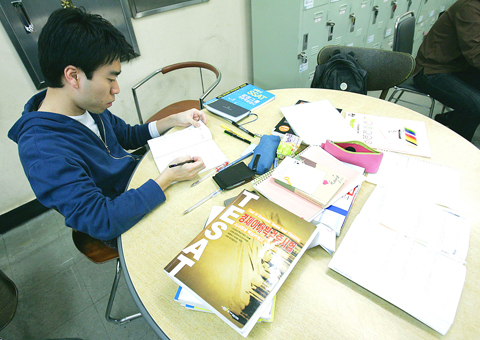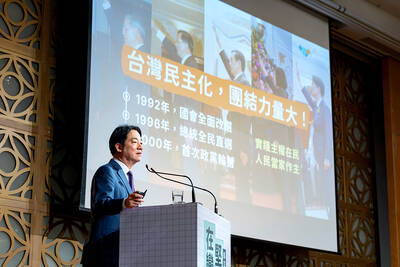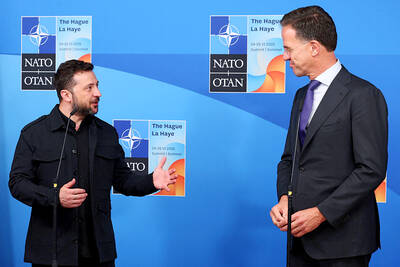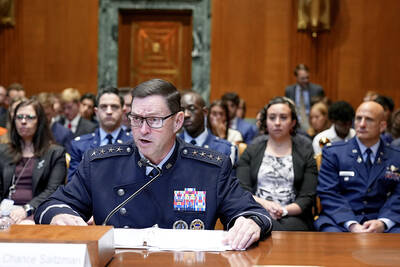South Korea’s newest batch of university graduates lives in fear of being trapped at the bottom of the pay scale in a group of workers dubbed the “880,000 Won Generation.”
The figure, equal to about US$650, represents about what a temporary staff or contract worker makes a month in net pay and is also a sign of the crushed dreams of the country’s youth who bet an elite education would lead to a rewarding career.
The current global crisis may cause South Korea to create its first generation of chronically underemployed and unemployed among the highly educated since the country emerged as a global economic power over the past few decades, experts said.

PHOTO: REUTERS
“Years ago, a diploma from a good university was a blank check for career success in Korea, but now it’s merely a certificate of unemployment,” said Cho, a university senior who asked only to be identified by her family name.
There are few places in the world where youth invest as much time and parents spend as large of a percentage of their income on education as South Korea, where cram schools are required to shut down by midnight so that students can have some sleep after studying for between 12 and 14 hours a day.
The goal has been entry to an elite university, which usually means a high-paying job, being considered a more desirable candidate for marriage and a level of prestige in the highly competitive society.
For many like Cho, the answer to the tough job market is even more education but experts are wondering if the current job crunch may be more than temporary and could signal an unraveling of social structures.
“There is a low empowerment level among people in their 20s,” said Woo Suk-hoon, an economics professor who coined the term 800,000 Won Generation in a recent book. “There is a much weaker social safety net in South Korea compared to what is offered in many OECD countries. This makes it easier for the country to sacrifice younger South Koreans in the labor market.”
A growing number of the young South Koreans have only been able to find temporary work. They see these posts as quicksand because the longer they stay, the more difficult it becomes for them to escape to join the regimented work force of regular workers who traditionally stay with one company for life.
The situation will likely get worse as the government predicts about 200,000 jobs will disappear this year while many private-sector economists warn of as many as 500,000 job losses.
Above a third of a million South Koreans aged between 20 and 29 were jobless in February, bringing the unemployment rate for the age group to 8.5 percent, more than double the nationwide jobless rate, the National Statistical Office said.
The government is aiming to ease the employment pinch through job-sharing and internship programs but Chu Duk-han, an activist who runs an online community for job seekers, sees this as nothing but a stop-gap measure.
“There are so many hopeless people who cannot even get those irregular jobs. The unemployment rate of the highly educated young people doesn’t tell the whole story. High school graduates are totally being excluded and ignored,” Chu said.
Kang Myung-koo, a 31-year-old high school graduate, said that he has not even been able to find a part-time job since last June when he lost a post at an online shopping mall in shipping.
“I am competing with college students for simple jobs with no age limits or academic requirements. I have nowhere to go. It’s hopeless. My bank account has dried up and the unemployment insurance benefits will stop soon,” Kang said.
Major employers such as Korea National Oil Corp, Hyundai Motor and the National Pension Service have said they plan to cut the wages of new hires.
In addition, many have said they will hire fewer regular employees and more contractors through internship programs.
“More and more companies are closing their doors for new full-time workers and hiring cheap interns instead,” said Park Young-ryeol, a professor of business administration at Yonsei University.
“I’m afraid this type of hiring is turning into a common practice,” Park said.

FREEDOM OF NAVIGATION: The UK would continue to reinforce ties with Taiwan ‘in a wide range of areas’ as a part of a ‘strong unofficial relationship,’ a paper said The UK plans to conduct more freedom of navigation operations in the Taiwan Strait and the South China Sea, British Secretary of State for Foreign, Commonwealth and Development Affairs David Lammy told the British House of Commons on Tuesday. British Member of Parliament Desmond Swayne said that the Royal Navy’s HMS Spey had passed through the Taiwan Strait “in pursuit of vital international freedom of navigation in the South China Sea.” Swayne asked Lammy whether he agreed that it was “proper and lawful” to do so, and if the UK would continue to carry out similar operations. Lammy replied “yes” to both questions. The

SECOND SPEECH: All political parties should work together to defend democracy, protect Taiwan and resist the CCP, despite their differences, the president said President William Lai (賴清德) yesterday discussed how pro-Taiwan and pro-Republic of China (ROC) groups can agree to maintain solidarity on the issue of protecting Taiwan and resisting the Chinese Communist Party (CCP). The talk, delivered last night at Taoyuan’s Hakka Youth Association, was the second in a series of 10 that Lai is scheduled to give across Taiwan. Citing Taiwanese democracy pioneer Chiang Wei-shui’s (蔣渭水) slogan that solidarity brings strength, Lai said it was a call for political parties to find consensus amid disagreements on behalf of bettering the nation. All political parties should work together to defend democracy, protect Taiwan and resist

By refusing to agree spending increases to appease US President Donald Trump, Spanish Prime Minister Pedro Sanchez threatened to derail a summit that NATO Secretary-General Mark Rutte needs to run smoothly for the sake of the military alliance’s future survival. Ahead of yesterday’s gathering in The Hague, Netherlands, things were going off the rails. European officials have expressed irritation at the spoiler role that Sanchez is playing when their No. 1 task is to line up behind a pledge to raise defense spending to 5 percent of GDP. Rutte needed to keep Spain in line while preventing others such as Slovakia

SHIFT PRIORITIES: The US should first help Taiwan respond to actions China is already taking, instead of focusing too heavily on deterring a large-scale invasion, an expert said US Air Force leaders on Thursday voiced concerns about the Chinese People’s Liberation Army’s (PLA) missile capabilities and its development of a “kill web,” and said that the US Department of Defense’s budget request for next year prioritizes bolstering defenses in the Indo-Pacific region due to the increasing threat posed by China. US experts said that a full-scale Chinese invasion of Taiwan is risky and unlikely, with Beijing more likely to pursue coercive tactics such as political warfare or blockades to achieve its goals. Senior air force and US Space Force leaders, including US Secretary of the Air Force Troy Meink and